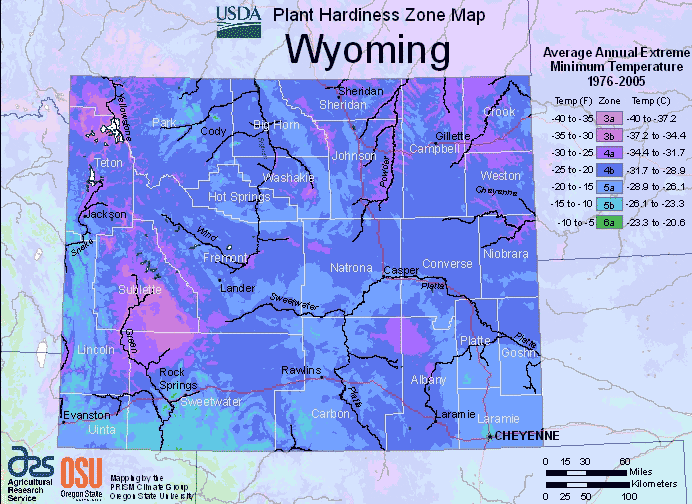
Table of Contents
Characteristics of Wyoming Planting Region
In summer, temperatures are relatively low, and the growing season is brief, with an average of only 115 frost-free days, which may be even less in some places.
Challenges of Growing in Wyoming
1. Shorter Growing Season
Unfortunately, Wyomingites experience an abridged growing season. Depending on where you live in the state, the last frost can be anytime between May and late July, with the first frost dates averaging between August and early October.
2. High Altitude
Gardening in Wyoming’s high altitude presents unique challenges due to the colder temperatures and shorter growing seasons. Gardeners need to select cold-hardy plants that can withstand the extreme weather conditions and employ techniques like season extension and choosing early-maturing varieties to make the most of the limited growing time.
3. High Winds
In Wyoming, winds can reach 30-40mph, with gusts of 50-60mph. It’s essential to cover your garden to prevent destruction from the strong and steady breeze.
4. Extreme Weather
In Wyoming, challenging weather like blizzards, thunderstorms, and hail make gardening a difficult job. Temperature fluctuations must be closely observed and accounted for to prevent harm to plants.
Thriving in the Cowboy State: Best Plants for Wyoming’s Planting Zone
Selecting the right plants is crucial to create a flourishing garden in Wyoming’s challenging environment. Here are some of the best plants to grow in Wyoming’s planting zone:
- Wyoming Big Sagebrush (Artemisia tridentata): As a native shrub, the Wyoming Big Sagebrush is well-adapted to the state’s dry and arid conditions. It provides essential habitat for wildlife and is a symbol of Wyoming’s rugged landscapes.
- Rocky Mountain Juniper (Juniperus scopulorum): This hardy evergreen tree is well-suited to Wyoming’s harsh climate. With its dense, blue-green foliage, the Rocky Mountain Juniper offers year-round beauty and can thrive in various soil types.
- Black-Eyed Susan (Rudbeckia hirta): These cheerful, drought-tolerant wildflowers are perfect for Wyoming gardens. Black-Eyed Susans bloom throughout the summer, adding a burst of color and attracting pollinators.
- Prairie Smoke (Geum triflorum): This unique native wildflower is known for its feathery seed heads that resemble smoke. Prairie Smoke adds an enchanting touch to Wyoming’s natural landscapes and is ideal for wildflower meadows.
- Russian Hawthorn (Crataegus ambigua): Russian Hawthorn is a hardy tree that can thrive in Wyoming’s planting zone. It produces clusters of white flowers in the spring and striking red berries in the fall, providing year-round interest.
- Blue Grama Grass (Bouteloua gracilis): As a native grass, Blue Grama is well-adapted to Wyoming’s climate. This warm-season grass features distinctive seed heads and is a valuable addition to wildflower gardens and natural landscapes.
- Pasqueflower (Pulsatilla patens): Also known as Prairie Crocus, Pasqueflower is an early spring bloomer in Wyoming. Its purple flowers add a touch of color to the barren landscapes, signaling the arrival of warmer weather.
- Indian Paintbrush (Castilleja spp.): These striking wildflowers are often associated with the landscapes of the American West. Indian Paintbrush adds vibrant splashes of red, orange, or yellow, creating a captivating display in meadows and prairies.
- Northern Pin Oak (Quercus ellipsoidalis): For gardeners in the eastern part of Wyoming, the Northern Pin Oak is an excellent choice. This hardy oak tree offers stunning fall foliage and can withstand cold temperatures.
- Purple Coneflower (Echinacea purpurea): This drought-tolerant perennial is a favorite among gardeners in Wyoming. Purple Coneflower features bold pink-purple flowers that attract butterflies and pollinators.
To ensure successful gardening in Wyoming, it’s crucial to consider the region’s cold winters, dry climate, and high-altitude conditions. Choosing plants that are cold-hardy and drought-tolerant is essential for their survival.
Mulching is vital to conserve moisture and protect plants during winter. Additionally, using windbreaks and planting in sheltered areas can help shield delicate plants from Wyoming’s strong winds.
Watering practices should be tailored to the specific needs of each plant and adjusted according to the weather conditions. Drip irrigation and other water-saving techniques are beneficial to maintain healthy plants without wasting water.
Native plants are particularly well-suited to Wyoming’s planting zone, as they have evolved to thrive in the region’s specific conditions. By incorporating native species into their gardens, gardeners can create landscapes that blend seamlessly with Wyoming’s natural beauty.
From the hardy evergreens like Rocky Mountain Juniper to the delicate beauty of Indian Paintbrush and Pasqueflower, the best plants for Wyoming gardens celebrate the state’s diverse landscapes and natural wonders. With careful selection and proper care, gardening enthusiasts can create stunning and sustainable gardens that thrive in Wyoming’s challenging climate.
FAQ
What climate zone is Wyoming?
The Wyoming climate zone is classified as semi-arid and continental, due to the Continental Divide.
What zone is Laramie?
Area 4b is a geographic region with a specific climate classification. It is characterized by a temperate climate, with cold winters and warm summers.
Region 4b has a temperate climate with cool winters and hot summers.
What is Zone 7 climate in USA?
Zone 7 winters typically have temperatures ranging from 0 to 10°F, including Long Island, NJ, MD, VA, NC, SC, TN, northern GA, AL, MS, and AR.
What planting zone is Casper Wyoming?
Verify your hardiness zone: Casper and the nearby area is in USDA Hardiness zone 5a, whereas the outside metropolitan area is 4b.
What does it mean to be in Zone 7?
USDA Hardiness Zone 7 has an average winter temperature range of 0-10°F (-17.8 to -12.2°C).
